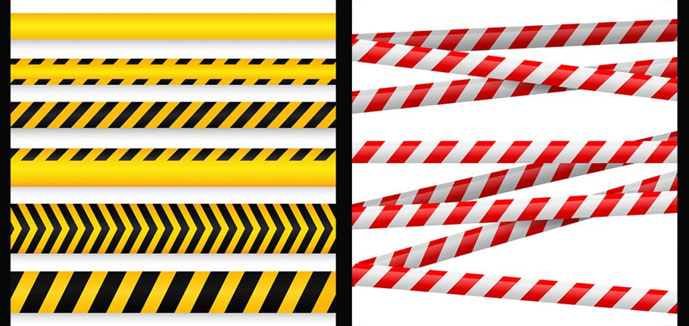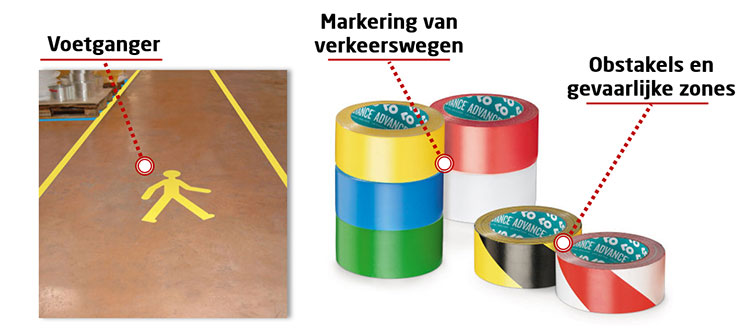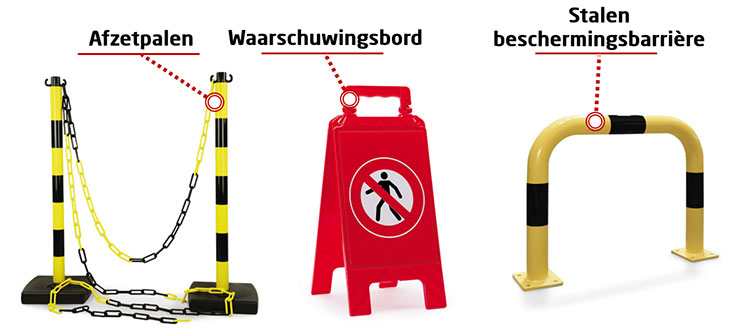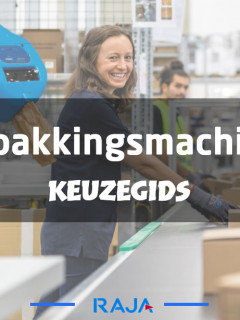Floor tape is used to clearly demarcate work zones in a warehouse. As in real road traffic, the lines also make it clear which routes to respect in the warehouse. So, as a pedestrian, you know where you can walk, where you can drive your forklift and where you have to put pallets. We show you the regulations, properties and types of floor tape here.
1. What types of floor tape are there?
► Single-coloured floor tape
]Tape or ribbons in one colour are used to demarcate areas and make traffic routes clear (for pedestrians or drivers). Ground marking should be clearly visible, in a colour that contrasts with the ground colour. A minimum width of 5 cm is usually recommended.
Floor markings for pedestrian areas (usually yellow) and parking areas for pallets or machinery (also yellow, white or sometimes blue) are often marked in one colour. This is not an official rule, but for recognisability it is advisable not to get too creative with this.
► Two-coloured floor tape
Using two-colour tape or ribbons to make it clear that you are entering an obstacle or hazardous area.
- Yellow/black: this indicates permanent obstacles. Consider, for example, the turning range of a door or the size of a loading dock.
- Red/white: this colour combination is universally used to mark temporary obstacles or dangerous places. In the form of a barrier tape, the red and white variant is most often used, both recreationally and by emergency services.

2. What are the regulations for floor tape?
When applying tape or cordon-off tapes, you must take into account the necessary safety distances between vehicles, objects and people. It is the employer’s job to ensure that the employee is informed about safety and health signs at work and necessary measures (see Work and Safety).
► Regulations for the marking of traffic routes
- Roadways for vehicles must be clearly marked with continuous stripes in a highly visible colour; preferably white or yellow – or a different colour depending on the ground.
- When applying the stripes, you must take into account the safety distances between vehicles, as well as between pedestrians and vehicles. There should always be sufficient room for movement.
- In a built-up area outside, permanent roads should not be marked, as long as you provide them with appropriate fencing or paving.
► Rules for signalling obstacles and hazardous areas
- To do this, use a tape or ribbon in alternating yellow and black, or red and white. Then apply these in all built-up areas of the company to which your employees have access.
- The yellow and black or red and white tapes should be printed at an angle of about 45° and have approximately the same dimensions.
- The dimensions of the signage should take into account the dimensions of the signalled obstacle or dangerous place.

3. What is the meaning of each colour?
Within the context of workplace safety, each colour has a particular meaning. We list them for you below.
| Red | – Ban – Danger (Stop!) –Fire-fighting and fire-fighting equipment –Warning (Beware, Exercise caution) |
| Yellow or orange | – Warning (Beware,Exercise caution) |
| Blue | – Command (Indication of an obligation or specific action, e.g. wearing personal protective equipment) |
| Green | – First aid (marking of doors, exits, equipment posts) – Safe situation |
4. Marking with tape or paint?
Using a floor tape has great advantages over painted lines. Tape is mainly used indoors. Unlike paint, you can apply tape faster and remove it more easily, and it is less likely to become dull. Moreover, tape needs no drying time, making it ready for use immediately. Finally, you can move floor tape if necessary. One disadvantage of tape is the fact that you are dependent on the colours and symbols that are commercially available. For special shapes, you will have to rely on homemade stencils and paint.
Marking paint is very suitable for outdoor use. Make sure the surface is dry and clean before you apply it. Choose paint with a high pigment content (and thus high opacity) if the surface is subjected to a lot of wear and tear. This can be the case, for example, in places where there is a lot of heavy traffic. With a line puller, you can apply perfectly straight lines.
]5. Temporary or permanent demarcation?
For those who only want to demarcate an area for a short time, floor tape (let alone paint) is not always the right solution. It is best to use bollards or safety cones. Their bright colours make them stand out immediately. To make dangerous situations or a command more obvious, you can, for example, place a folding warning sign on the floor. The handle makes them easy to place anywhere.
Finally, a word about metal barriers. Floor tape or ribbons do not always guarantee that instructions are followed correctly. Tape on the floor may be slightly less noticeable and ribbons can fall off. A permanent and extra safe solution is then the metal protective barrier. They are yellow (with or without black stripes) and can be firmly anchored into the ground. Pedestrians, vehicles, racks and pallets are thus optimally protected against collisions or impacts.















